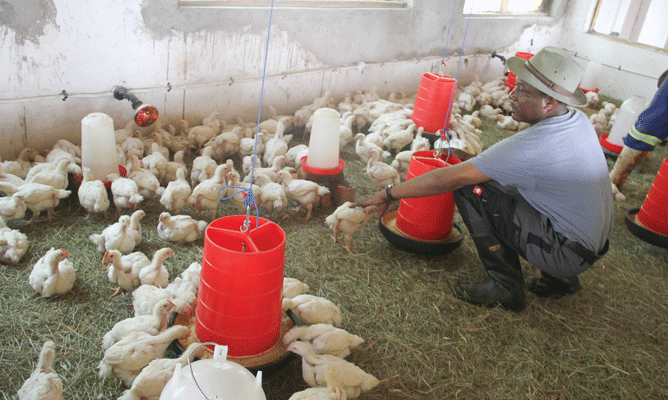Poultry farmers cry foul over feed prices
WHILE bitter memories of the January disease holocaust that claimed in excess of 100 000 cattle countrywide and the 2018/19 drought that ravaged crops leaving many people economically and food-insecure were yet to retreat to the back of their minds, a lot was also happening in the poultry industry.
Facts from the second round crop and livestock assessment indicate that a total of 74 million day-old broiler chicks were produced in 2019, a 19 percent decline from the 91 million chicks produced in 2018. The decrease was attributed to the of high costs of production that saw many farmers either scale down operations or temporarily close shop to escape losses.
On the brighter side of things, there was an estimated 24 percent increase in table egg production recorded in 2019 (50,4 million dozen) compared to 36, 4 million dozen the previous year.
Once again, the high stock feed prices were fingered as the chief culprit stifling enterprise viability. Of course there were no major disease outbreaks to talk about this time around.
Broiler day old chick production averaged 6,2 million chicks a month with a total annual production of 74 million in 2019 with meat production in essence also declining from 143 000 tonnes to 114 000 tonnes, representing a change of 20 percent, which was a direct result of reduced production.
One exciting observation, however, is that broiler production continues to be dominated by small-scale farmers who are doing it at various scales but still managing to claim their fair share of the market.
Broiler farming is naturally attractive to many farmers owing to the short nature of the time it takes from the point they buy the day-old chicks to the point of slaughter and sale. It is a matter of between four and six weeks and the farmer will be getting returns from the project.
She only needs to do active marketing so that she does not keep the birds beyond the expected point of sale time to curtail losses.
Overall table egg production recorded an estimated 24 percent increase from 36,4 million dozen in 2018 to 50,4 million dozen in 2019.
Of course this was still lower than the 2016 high of 55,3 million dozen but the redeeming factor is that both large-scale and small-scale farmers recorded increases in table egg production.
Such increases in the scale of production also mean an increase in revenue generated at the conclusion of an enterprise if it is properly managed.
But it is the prices of the feeds that have continued to give farmers a torrid time with some of them scaling down production or turning to home-grown solutions that in a way also took a toll on the quality of the final product.
Prices of feeds have been on an upward trajectory between January and May this year with broiler starter mash priced at $640 at the beginning of the year but hitting $1 290 by May.
Similarly, broiler finisher started off at $620 in January and rose to $1 250 by May while layers’ mash was selling for $527 at the beginning of the year but rose to $1 064 at the beginning of May.
The prices of all stock feeds in general increased by more than 100 percent.
The painful reality on the ground is that stock feeds for all species are available on the market but they are priced out of reach for most smallholder farmers. This has affected viability of most enterprises. Farmers, especially those into poultry and piggery, have had to scale down operations.
The major driver of the high cost of stock feeds is the shortage of locally produced raw materials, leading to importing against foreign currency shortages.
The other challenges farmers are facing come in the form of prices that are being quoted in hard currency, which most retailers seem to have connived to adopt, yet the Government is on record saying the economy will not dollarise.
Many people are now pinning their hopes on the forex auctions that Government introduced to help stabilise the exchange rate, but the suppliers of feeds and other basic requirements are using black market rates that make it very difficult for farmers to secure the foreign currency.
Those farmers doing mixed farming have since resorted to making their own feed formulations in which they mix various crops and come up with some feeds for their chicks but the problem is that in most cases they do not get expert instruction when they do so.
The option has in many cases helped them slash the costs of production, but the rate of growth of the birds has also been affected.
Farmers that I have come across doing the practice usually mix maize, sorghum, sunflowers and in some cases soya beans, but the problem mostly comes when they need to make the correct portions of each. The other issue is on the availability of some of the crops such as soya beans, which is not very common with the majority of farmers.
I have noticed that some farmers have started producing sunflower, ostensibly to make sure they do not spend much on the procurement of feeds.
On a national scale, sunflower production has increased from 6 356 tonnes in the 2018/2019 cropping season to 9 447 tonnes in the 2019/2020 season marking a 49 percent increase at an average yield of 0,38 tonnes per hectare.
This means that the farmers currently involved in the production of the crop need to improve their agronomic knowledge of the crop and boost their yields in the end.
It also means that there will soon be growing demand for the crop, which will avail more local markets for farmers producing sunflowers.
On the other hand, extension officers may also need to extend their teachings to cover chicken production and this will include making feed formulations so that farmers can do it correctly and cut on the costs of production.=–herald.co.zw











